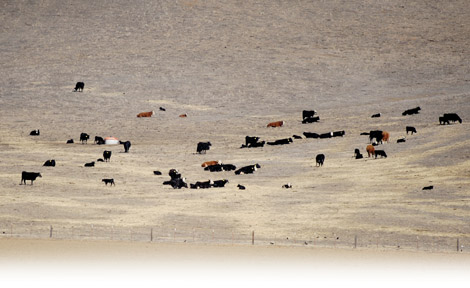San Benito County maintained its reputation as a bastion of agriculture again in 2011 when the value of local crops and livestock increased by $8 million over numbers from 2010.
The market for agriculture items fluctuates each year and some of the commodities that were bolstered in 2011 are expected to be down for 2012.
“The cattle producers, a lot of them had to ship their calves early because they ran out of feed,” said Ron Ross, the agricultural commissioner for San Benito County, echoing a theme heard across the nation with the ongoing drought. “The ones that did keep their cattle on rangeland had to accrue extra expense. They had to purchase hay.”
While other crops can be maintained in dry years with blue valve water from the Central Valley Water Project, rangelands are hurt when the winter is drier as it was this year.
“This year there has been some adverse weather that can affect the bottom line of the ranchers this year,” he said.
The drought is not isolated to San Benito County or California. The National Cattlemen’s Beef Association reported that unlike past years when droughts were more regional, the 2012 drought has been widespread, affecting 70 percent of the cattle inventory in the U.S.
“The widespread drought has ultimately led to the worst pasture conditions in the past 15 years,” said Kevin Good, a senior market analyst for CattleFax. “The U.S. calf crop is down 800,000 head.”
While cattle production may be down in 2012, Ross said specialty vegetable crops are continuing to grow in San Benito.
“One of the things this area does have is a fairly abundant water supply and agriculture infrastructure already in place,” Ross said, referring to the blue valve water. “A lot of growers have relocated crops to this area.”
Ross presented the 2011 crop report to the county board of supervisors Tuesday. He said the increase in commodity value to more than $263 million was largely due to an increased acreage of specialty crops and an increase in the value of livestock.
The 2011 crop value is the highest since 2007. In 2010, the county had $255.5 million in agricultural commodities.
In 2011, the value of vegetable and row crops, cattle, poultry and other livestock products was up – while field crops, fruit and nut crops were down. Vegetable and row crops make up 65 percent of the agricultural commodities in the county.
“We had a really wet spring and summer that affected many crops,” Ross said, adding that fruit and nut tree crops were down from the previous year. “We are very diverse.”
Ross said the diversity of the crops and livestock raised in the county helps growers manage some years when the weather hits certain crops harder than others. He said the county is one of the top five producers in the state for several specialty crops, including romaine lettuce, spinach, garlic, artichokes and sweet peppers.
The acreage of wine grapes was down in 2011 to 3,651 acres from 3,591 the year before.
In addition, the wine grapes were hit by poor weather conditions, leading to 13,728 tons produced instead of the nearly 19,000 tons produced the year before.
“I wanted to talk about the fruit and nuts,” Barrios said, at the meeting. “Four areas have gone down, but I am concerned about the grapes.”
Barrios said she had hoped the acreage of vineyards would be on the rise in the county because supervisors want the local wineries to become a draw for tourists.
“Last year there was a slight decrease, but this year there has been an increase in production,” Ross said. “Weather impacted the grapes. We had substantially cold weather in the spring and wet weather, and a cool summer.”
But he said wine grapes should be on the increase in future years.
“That will be good for the wine industry,” Barrios said.
Ross noted that new vines planted in the Panoche Valley will take a year or two before they start to produce wine grapes.
The types of organic crops continued to increase in the community, with 64 organic growers providing 74 different crops.
The values reflected in the crop report are gross values and do not reflect net profit to local farmers and ranchers. At the meeting Ross said the value of agriculture does help other local industries. He said farm operations use diesel fuel, redo irrigation pipes each year, use fertilizer and pesticides, and maintain equipment.
“It’s not just the gross products, but the multiplier effect that is put back into the equation to be able to produce it,” Ross said.










